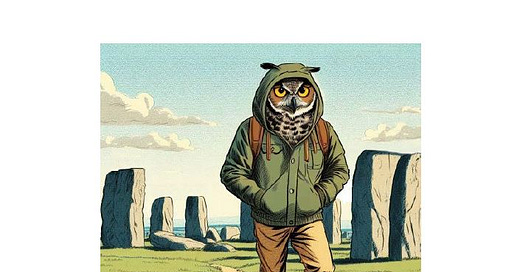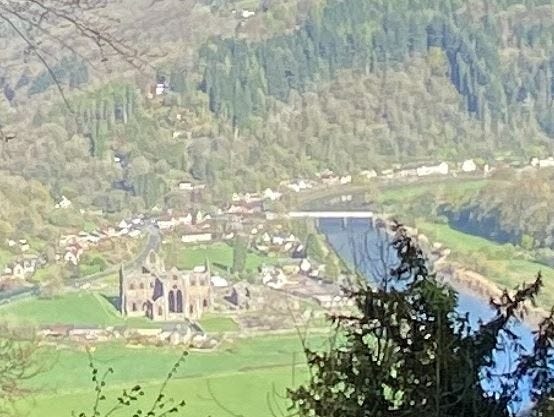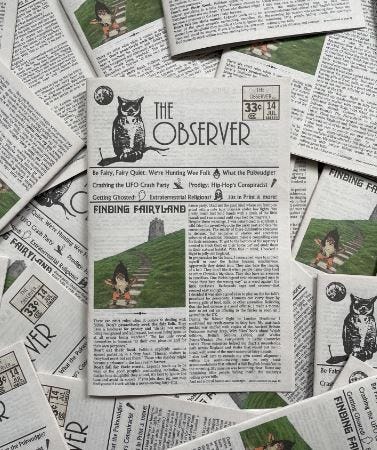Read Part 1 and Part 2
Avebury
Having made a tangible offering to the little people back in London, I rented a car and headed west towards Wales. I needed to escape the throngs of people and urban sprawl that defined the area around London. But first, a side trip to the town of Avebury was in order to overturn stones and get a sense for one the fairies’ rumored stomping grounds.
I was treated to the proper English experience as soon as I parked. Light rain was falling from a muted gray backdrop. This became a fixture for the next four days. Full of optimism for the time being, I donned a waterproof jacket and boots and made the short trek to the town’s famous stone sanctuary.
Avebury is known for the cache of ancient henges in and around the town. Some legends attribute these to the good folk, claiming they serve as an entrance to Fairyland. Other tales are more sinister. Wanderers who become trapped within the megaliths are either transported to an alternate dimension or transformed into a standing stone themselves.

Turning the brim of my hat to the back for good measure, I stepped within the site’s southwest arrangement. My first instinct was to avoid contact with the stones. Even standing too closely felt like I was breaching some sacred barrier. But then the rain picked up, and I learned that they make an excellent shelter from the elements.
Maybe it was the wrong time of day—or maybe it was the weather—but despite the idyllic setting, I didn’t get the feeling that there were any fairies lurking about. No tiny paths or holes beneath the rocks to betray their presence. After a delightful afternoon exploring the area, I popped into a local tourist trap to grab a small gnome figurine. I was hopeful that carrying around a replica might attract other fairies—like ducks to a decoy.
Silbury Hill
Before leaving Avebury I made a point to investigate the tallest prehistoric monument in Europe. Ominous and foreboding, Silbury Hill rises steeply from the surrounding landscape. So far, archaeological excavations have yielded no evidence of treasure or tomb. Prevailing scholarship suggests it could have acted as a beacon or sacred site to the region’s ancient settlers.
The mound looks like the perfect place to house a whole heap of fairies—like an apartment complex version of Bilbo Baggins’ hillside hobbit home. Reverend Kirk’s book—The Secret Commonwealth of Elves, Fauns, and Fairies—explained that the good folk were “subterranean inhabitants,” known to reside in caves, mountains, rocks or hillsides. Silbury Hill’s unique appearance and proximity to Avebury’s standing stones made it an unparalleled place to conceal a fairy kingdom. I needed a closer look.
After a short trudge across a field I was stopped by an impassable barrier of water. Getting across the 30-foot-deep moat to investigate the 130-foot-tall hill up-close wasn’t in the cards. Besides, fairy forts were best avoided at all hours of the day, but they were especially dangerous after nightfall. Ethereal beings seem to gain strength when the sun goes down. Since the evening was quickly wearing on, I put the hill at my back and made tracks for my lodging. Next stop: the Welsh side of the England/Wales border and the small riverside town of Tintern.
Wales
The Welsh woodlands are rumored to be teeming with the good folk, or as they’re known in Wales, the “Tylwyth Teg.”
I chose the picturesque town of Tintern due to its associations with the Devil. Pockets of folklore view fairies as the biblical host that was tossed out of Heaven during Satan’s rebellion. Instead of playful nymphs, some know them as demonic beings aligned with the “old wise one.” Reverend Edmund Jones referred to the fair folk as “worms of darkness,” and warned that welcoming one into your home was akin to making “a covenant with Hell.” If the little people were in league with Lucifer, Tintern seemed like a decent place to draw them out.
Legend has it that the Devil installed a limestone pulpit overlooking Tintern’s incredible Abbey so that he could harass the monks in the valley below. The friars got the last laugh when they lured him into their quarters and doused him with holy water.
Wanting the trail to myself, I started the morning with a 1.5 mile hike up to the Devil’s Pulpit. The path roams over open fields and dense forests before depositing hikers at the stone outcrop that bears the evil one’s name. The “pulpit” itself offers a breathtaking view of the Wye River and the skeletal ruins of Tintern Abbey.
Throughout my expedition I kept my head on a swivel for anything moving in the underbrush, eager to catch a glimpse of green out of the corner of my eye. Except for a guy and his dog camping just off the trail, the scene was disappointingly quiet. I wasn’t surprised. Fairies as fallen angels didn’t seem right, somehow. The mythology makes it clear that the good folk wanted nothing to do with any aspect of religion—the Devil included.
After a hearty breakfast at a local B&B, I followed the river north to the village of Hay on Wye, and spent the afternoon wandering its bookstore-lined streets. I left with with an armful of books about the region’s fairy mythology before carrying on to my next port of call—a location with “more folklore attached to it than any other site in England.”
Part 4: The Conclusion (finally), coming soon.
















I'd definitely hit up some of those bookstores. Colin Wilson... Some others...
You know they don't exist in the physical realm, right? Might catch them out of the corner of your eye, or in reflections.
Should try some dowsing or pendulums at some of those sites you're visiting. Geomancy.
Sounds like a fun adventure anyway!
Next stop, ICELAND.
There's always 🍄 🍄 🍄...
You make me want to travel back to the motherland so I can wander the streets of endless used book stores. Hope you are enjoying the trip!